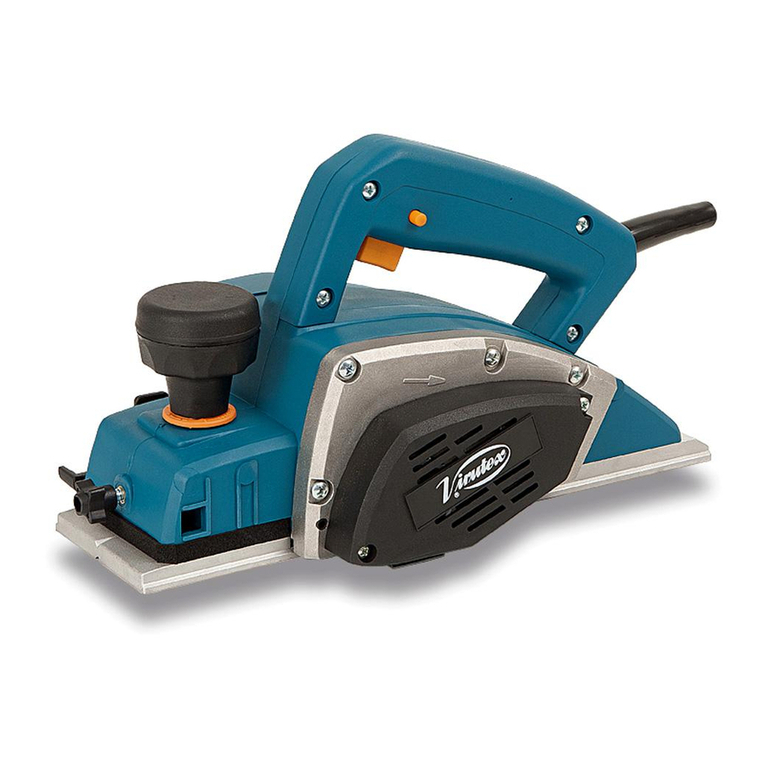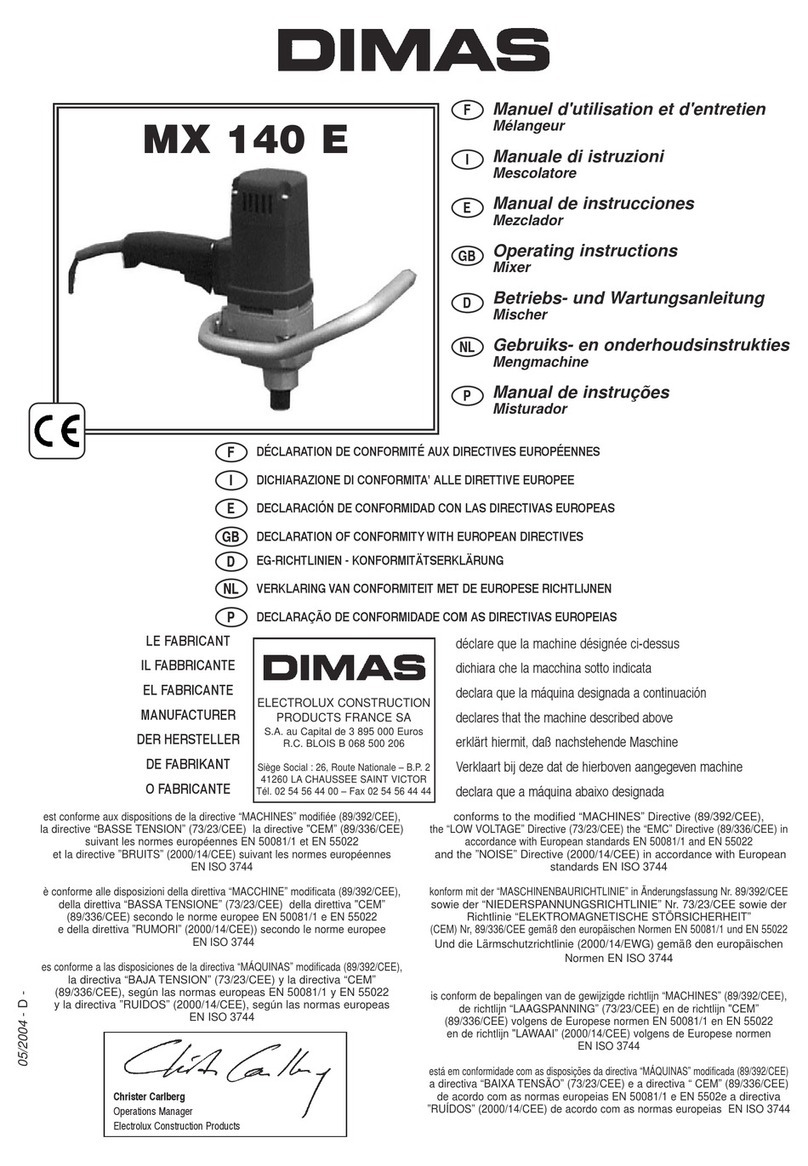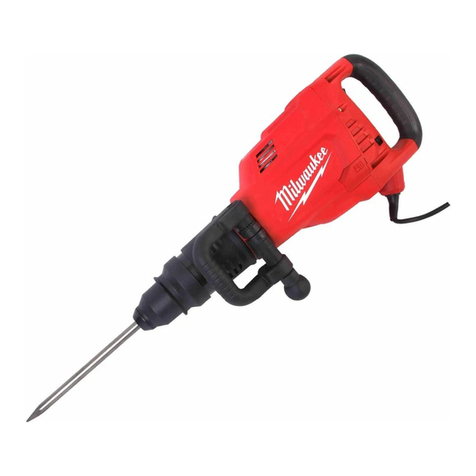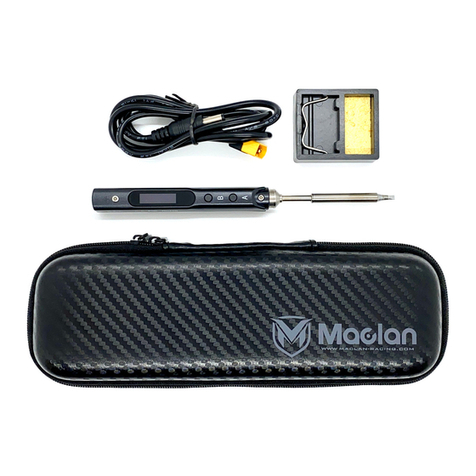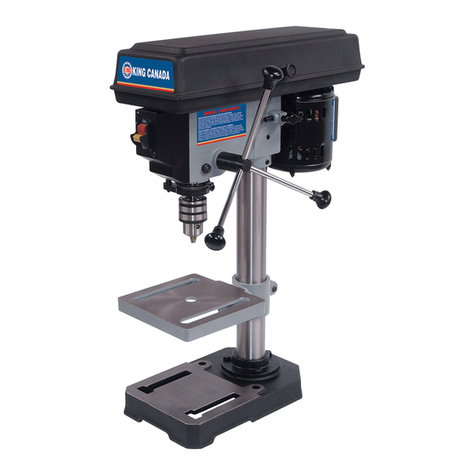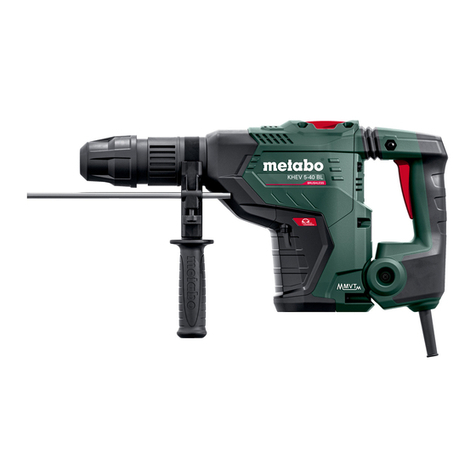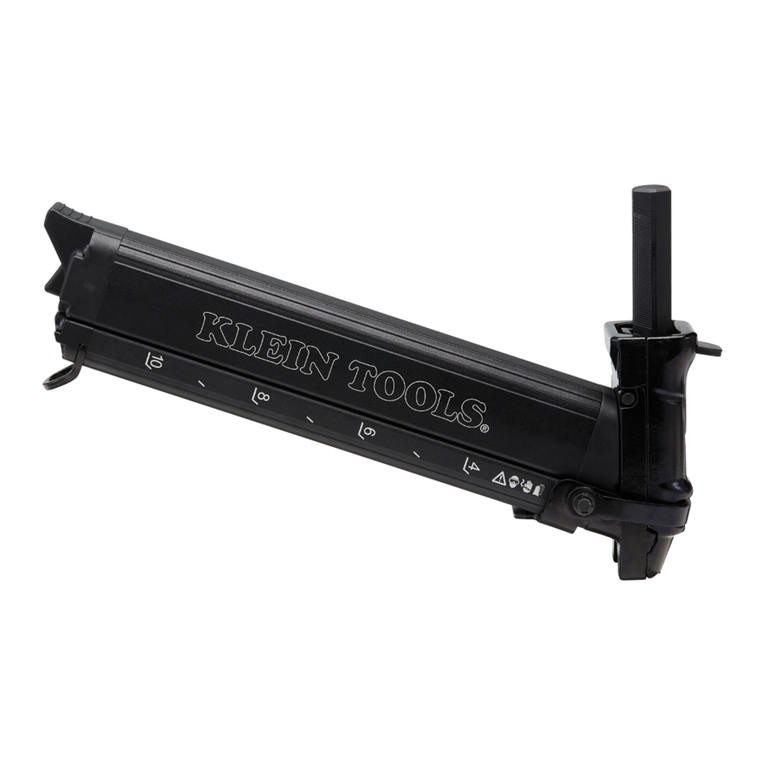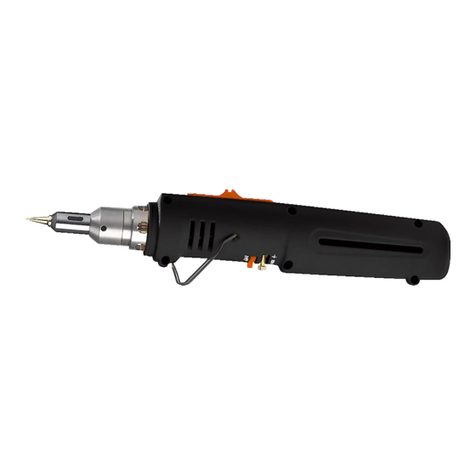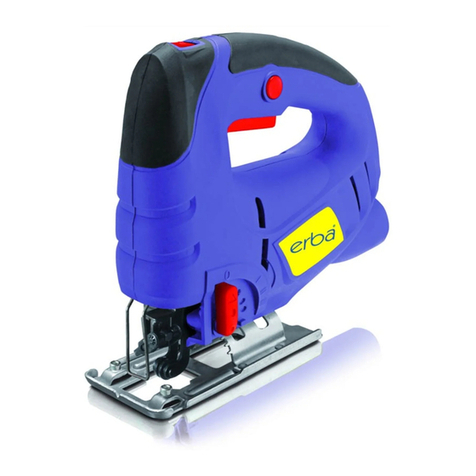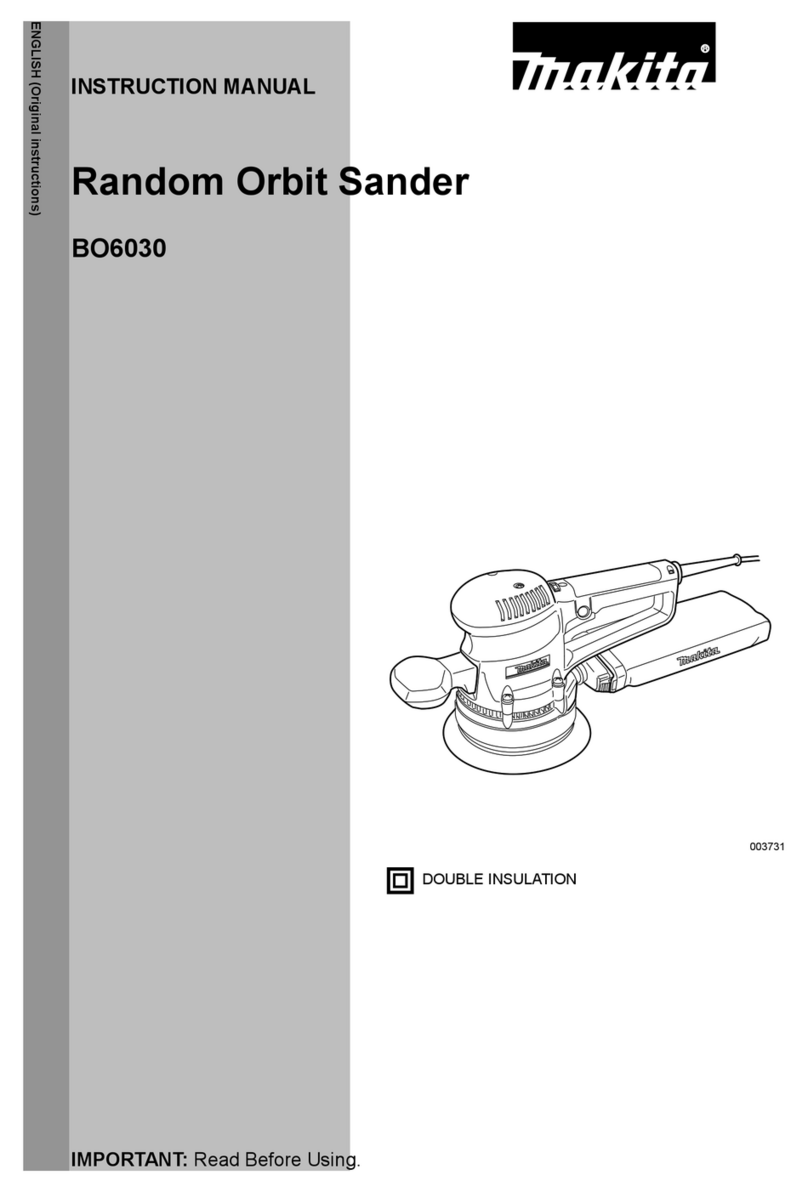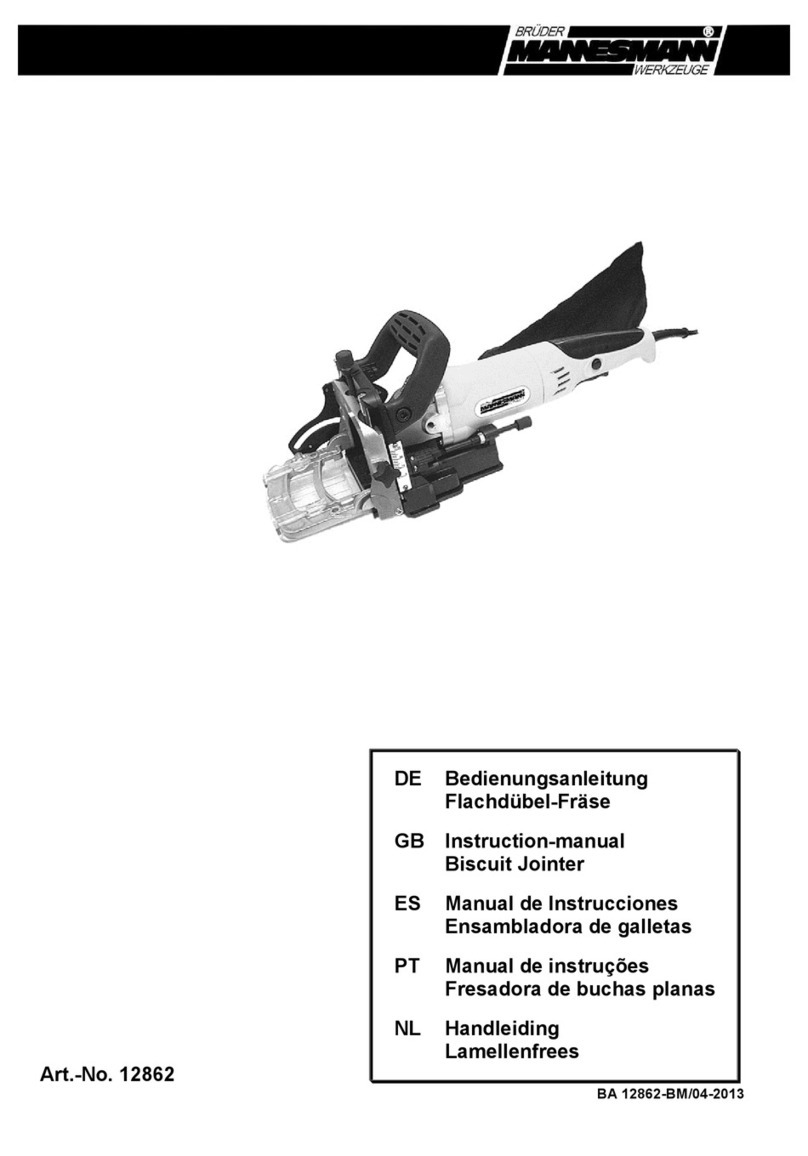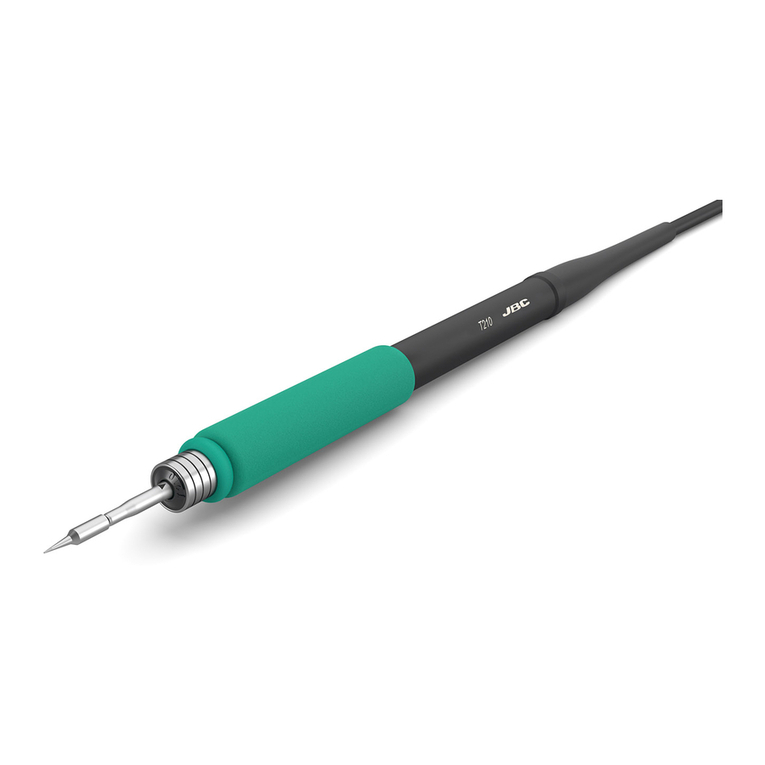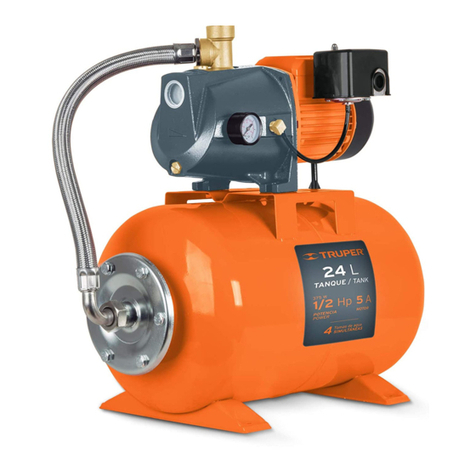Barnes MEK-18 User manual

MUNSCH Kunststoff-Schweißtechnik GmbH Issue 08.2008/Rev. 00 Page 1/20
Operating Instructions
Type: MEK-18 / MAK-18 Serial No.: ______________
Article No.: ______________
These operating instructions contain important information to
be observed for hand extruder operation and maintenance.
It is therefore imperative that they be read and their contents fully
understood by the operators before the hand extruder is placed in
service.
MEK 18B & MAK 18B

Hand Extruder MEK-18 / MAK-18
Page 2/20 Issue 08.2008/Rev. 00 MUNSCH Kunststoff-Schweißtechnik GmbH
Scope of delivery:
Please check that the delivery is complete.
The delivery comprises:
1 hand extruder
1) Container engineering design: fillet weld a = 7mm, 40mm long
1 handle
1) Landfill construction design: sheeting/film weld 25mm, 40mm
long
1 welding shoe, machined
1)
1 extruder stand
1 hot air hood
Contents
1
GENERAL......................................................................................................................................................................4
2
SAFETY..........................................................................................................................................................................4
2.1
I
DENTIFICATION OF INFORMATION IN THE OPERATING INSTRUCTIONS
.......................................................................5
2.2
P
ERSONNEL QUALIFICATION AND TRAINING
..............................................................................................................5
2.3
R
ISKS RESULTING FROM NON
-
OBSERVANCE OF THE SAFETY INSTRUCTIONS
..............................................................5
2.4
S
AFE WORKING PRACTICES
........................................................................................................................................5
2.5
S
AFETY INSTRUCTIONS FOR
O
PERATOR
/
OPERATING PERSONNEL
.............................................................................5
2.6
S
AFETY INSTRUCTIONS FOR MAINTENANCE
,
INSPECTION AND MOUNTING
.................................................................7
2.7
U
NAUTHORIZED MODIFICATIONS AND SPARE PARTS
..................................................................................................7
3
TRANSPORT AND STORAGE...................................................................................................................................8
3.1
T
RANSPORT
...............................................................................................................................................................8
3.2
S
TORAGE
...................................................................................................................................................................8
3.3
R
ETURN TO
M
UNSCH
.................................................................................................................................................8
4
PRODUCT DESCRIPTION .........................................................................................................................................8
4.1
A
PPLICATION RANGE
.................................................................................................................................................8
4.2
G
ENERAL
...................................................................................................................................................................8
5
STARTUP AND SHUTOFF..........................................................................................................................................9
5.1
G
ENERAL
...................................................................................................................................................................9
5.2
P
REPARATION
............................................................................................................................................................9
5.3
S
TARTING THE HAND EXTRUDER
.............................................................................................................................10
5.4
W
ELDING WITH THE HAND EXTRUDER
.....................................................................................................................11
5.4.1
Introducing the welding rod............................................................................................................................11
5.4.2
Replacement and aging of welding rod...........................................................................................................11
5.4.3
Welding direction / rate ..................................................................................................................................11
5.4.4
Interruption of work........................................................................................................................................11
5.4.5
Shutoff ............................................................................................................................................................12
5.4.6
Transport/Storage............................................................................................................................................12
5.5
S
ET TEMPERATURES ON TEMPERATURE CONTROLLER
.............................................................................................12
5.5.1
Set temperatures..............................................................................................................................................12
6
MAINTENANCE/INSPECTION ...............................................................................................................................14
6.1
M
AINTENANCE
/
INSPECTION OF
MEK/MAK
HAND EXTRUDER
................................................................................14
6.2
D
ISMANTLING
..........................................................................................................................................................14
6.2.1
Overview of spare parts / attachments ............................................................................................................14
7
MALFUNCTION, CAUSES AND REMEDIES........................................................................................................16
7.1
T
ROUBLE
-
SHOOTING
................................................................................................................................................16
7.2
F
AULT DIAGNOSIS
....................................................................................................................................................16
8
TECHNICAL DATA ...................................................................................................................................................18

Hand Extruder MEK-18 / MAK-18
Page 4/20 Issue 08.2008/Rev. 00 MUNSCH Kunststoff-Schweißtechnik GmbH
1 General
These operating instructions must always
be available at the place of use of the hand ex-
truder.
The objective of these operating instructions is to
support operators in familiarizing themselves with the
hand extruder and in using its functions for the in-
tended service.
These operating instructions provide important in-
formation for the safe, workmanlike and economical
operation of the hand extruder. Their observance
helps avoid danger, minimize repair costs and down-
times, enhance reliability, and extend the service life
of the hand extruder.
These operating instructions must be observed by all
persons working with/on the hand extruder. Such
work includes, for instance:
•operation,
•maintenance, inspection and repair
•transport.
The hand extruder may only be mounted, operated
and maintained by trained personnel.
In addition to the operating instructions and the na-
tional and local accident prevention regulations ap-
plicable at the place of use, the acknowledged tech-
nical rules for safe and proper working practices
must be observed.
These operating instructions provide basic informa-
tion to be observed for operation and maintenance.
For this reason, it is imperative that they be read by
the specialist personnel/Operator prior to placing the
hand extruder in service and that they always be
available at the place of use.
Apart from the general safety instructions under sec-
tion “Safety“, also the special safety instructions
given under the respective sub-sections must be
adhered to.
Non-observance of the safety instructions
may cause hazards to persons and the environment
or damage to the hand extruder.
Moreover, failure to observe the safety instructions
may lead to the forfeiture of any damages.
Non-observance of the safety instructions may in
particular involve the following risks:
•failure of important hand extruder functions,
•hazards to persons due to electrical and me-
chanical impacts including risk of burns,
•hazards to the environment due to vapour-phase
hazardous substances,
•risk of fire.
2 Safety
These operating instructions provide basic informa-
tion to be observed for operation and maintenance.
For this reason, it is imperative that they be read by
the specialist personnel/Operator prior to placing the
hand extruder in service and that they always be
available at the place of use.
Safe operation of the hand extruder presupposes
that the instructions under section 1 – General – of
these operating instructions are complied with. In no
case must the limit values indicated be violated.
Intact and unaltered hand extruders conform to the
applicable codes and standards and meet all regula-
tory limit values regarding EMC (electromagnetic
discharges and interference immunity). For the coun-
try-specific limit values to be observed, the Operator
should consult the local electric utility. Nevertheless,
the hand extruders emit electromagnetic fields within
the acceptable limits. Electromagnetic fields may
interfere with the operation of vital electronic devices
(e.g. cardiac pacemakers). Persons wearing a car-
diac pacemaker should therefore consult their physi-
cian before using the machine.
In addition to the operating instructions and the na-
tional and local accident prevention regulations ap-
plicable at the place of use, the acknowledged tech-
nical rules for safe and proper working practices
must be observed.
Apart from the general safety instructions under sec-
tion “Safety“, also the special safety instructions
given under the respective sub-sections must be
adhered to.
Any working practices posing a safety risk are pro-
hibited.

MEK-18 / MAK-18 Issue 08.2008/Rev. 00 Page 5/20
2.3 Risks resulting from non-observance of the
safety instructions
Non-observance of the safety instructions may cause
hazards to persons and the environment or damage
to the hand extruder. Moreover, failure to observe
the safety instructions may lead to the forfeiture of
any damages.
Non-observance of the safety instructions may in
particular involve the following risks:
•failure of important hand extruder functions,
•hazards to persons due to electrical and me-
chanical impacts including risk of burns,
•hazards to the environment due to vapour-phase
hazardous substances,
•risk of fire.
2.4 Safe working practices
The safety instructions given in these operating in-
structions, the applicable national accident preven-
tion regulations and any existing in-company work
instructions, operating and safety procedures issued
by the Operator must be followed.
2.5 Safety instructions for Operator / operating
personnel
•Before placing the hand extruder in service,
check the mains voltage and frequency against
the data indicated on the type tag. The allowable
tolerances are ± 5 % for voltage and/or ±2 % for
frequency.
•According to VDE 0100 §55, the hand extruder
must be operated via a residual current-operated
circuit breaker or an isolating transformer.
•CAUTION During hand extruder operation (under
load), a voltage of not less than 230 V
1)
must be
available at the connector of the hand extruder.
•When using an extension cable, make sure to
observe the minimum conductor cross-section.
Use extension cables with protective conductor
only.
Length
[m] Minimum cross-section
[mm²]
up to 19 4.0
1)
20-50 6.0
1)
2.1 Identification of information in the operating
instructions
In these operating instructions, safety instructions
whose non-observance may cause hazards to per-
sons are identified with
Hazard symbol according to DIN 4844 – W 9
for general hazards and with
Hazard symbol according to DIN 4844 – W 8
for electrical hazards.
Safety instructions whose non-observance may
cause damage to the hand extruder and its functions
are marked with
CAUTION
Instructions directly indicated on the hand extruder
must be strictly followed and kept in a fully legible
state.
2.2 Personnel qualification and training
The operating, maintenance and inspection person-
nel must possess appropriate qualification for the
work to be performed. Functional and technical re-
sponsibilities and supervision of the operating per-
sonnel must be clearly regulated by the Operator.
Where the personnel do not have the necessary
skills and knowledge they must be trained and in-
structed (e.g. a DVS basic welder training in extru-
sion welding). A detailed instruction into hand ex-
truder operation will be provided by the Manufac-
turer/Supplier on request. Furthermore, the Operator
has to make sure that the contents of the operating
instructions is fully understood by the operating per-
sonnel.
1) for 230 V AC

Hand Extruder MEK-18 / MAK-18
Page 6/20 Issue 08.2008/Rev. 00 MUNSCH Kunststoff-Schweißtechnik GmbH
•Extension cables must be certified for the specific
service conditions (e.g. outdoor service) and
identified accordingly.
Always handle the connecting cable with care.
- Do not kink the connecting cable.
- Do not place any objects on the cable.
- Do not jam or squeeze the connecting cable,
nor pull it over sharp edges.
- Protect the connecting cable from moisture.
•Do not touch the mains connector or con-
necting cable with wet hands. Hold the cable al-
ways at the connector when plugging or unplug-
ging it.
•CAUTION Power generator sets used for power
supply must be designed for the following rated
output:
≥4 x rated output of hand extruder
•Never allow the hand extruder to come into
contact with water: Hazard to persons and
equipment, short-circuit risk.
•CAUTION Never operate the hand extruder
without air supply; risk of hand extruder dam-
age.
When using an external air source, make sure
that the air supply line is adequately dimen-
sioned.
•CAUTION The supply air must be clean, dry and
free from oil and water.
•The hand extruder must not be used in
explosion hazard areas or flammable atmos-
pheres.
Make sure that the hand extruder is firmly posi-
tioned during the extrusion welding job.
The connecting cable, welding rod and hose for
external air supply, if applicable, must be freely
movable and must not obstruct the operator or
third parties in their work.
•Hold and touch the hand extruder only on
the handles provided for this purpose.
- Do not touch bare metal parts (including hot
air hood) either with or without gloves. These
parts reach temperatures of up to 350 °C.
- Attachments may be damaged or impaired
in their function if subjected to the full weight
of the hand extruder.
- Bare metal parts must not come into contact
with other items during the work or work
breaks (e.g. cooling).
D02-0001
•Contact of combustible components
with hot bare metal parts poses a risk of fire!
Do not use synthetic gloves!

MEK-18 / MAK-18 Issue 08.2008/Rev. 00 Page 7/20
•Do not direct the hot air jet of the hand extruder
towards living beings or temperature-sensitive
items.
Safety distance: 2 m radius
B
ILD
D02-0002
•Use suitable personal protection equipment for
overhead work (e.g. hard hat, safety goggles,
gloves, protective clothes …) to guard against
falling items.
•During work breaks and after completion of the
welding job, place the hand extruder on the rests
supplied for this purpose.
CAUTION The hot air hood must be remounted.
Make sure that the hand extruder is firmly
positioned!
Deposit the hand extruder in a dry location.
After completion of the welding job, cool the hand
extruder to safe-to-touch temperature, using the
air supply system.
•Do not operate, dismantle or carry out any
modifications on the hand extruder, if
- the connecting cable or the mains connector
is defective,
- safety devices are damaged,
- foreign matter or liquid has penetrated into the
hand extruder,
- the unit does not work properly or there are
unusual changes in its operating behaviour.
•Never allow the hand extruder to come into
contact with water: Hazard to persons and
equipment, short-circuit risk.
2.6 Safety instructions for maintenance, inspec-
tion and mounting
The Operator is responsible for ensuring that main-
tenance, inspection and mounting activities are per-
formed by authorized and qualified personnel who
are thoroughly familiar with the operating instruc-
tions.
•As a rule, the hand extruder must be shut off and
the connector unplugged before proceeding to
any work on the unit. The shutoff procedure for
the hand extruder described in the operating in-
structions must be strictly observed.
•Electrical hazards must be ruled out (for details,
see VDE guidelines and the standards of your lo-
cal electric utility, for instance).
•VDE 0701 (IEC 335) prescribes the meas-
urement of the protective conductor resistance,
insulation resistance and leakage current after
each repair or modification to electrical equip-
ment. Furthermore, a visual inspection of the unit
and its connecting cable as well as voltage and
current measurements and a function test must
be carried out.
•Ensure the safe and environmentally compatible
disposal of media, auxiliary materials and re-
placed parts!
•Remount and reactivate all safety and protective
devices immediately on completion of the main-
tenance, inspection or repair work.
2.7 Unauthorized modifications and spare parts
Modifications or changes to the unit are only allowed
after consultation with the Manufacturer. In the inter-
est of safety, only original spare parts and accesso-
ries authorized by the Manufacturer should be used.
The use of components other than the original spare
parts may invalidate the Manufacturer’s liability for
any resulting damage.
D02-0002
360°
2m(6ft)

Hand Extruder MEK-18 / MAK-18
Page 8/20 Issue 08.2008/Rev. 00 MUNSCH Kunststoff-Schweißtechnik GmbH
3 Transport and Storage
3.1 Transport
•Before transport and storage, make
sure that the hand extruder has cooled down
to safe-to-touch temperature.
•Hold and touch the hand extruder only on
the handles provided for this purpose.
Do not touch bare metal parts (including the hot
air hood) – whether with or without gloves – be-
fore having made sure that they are safe to touch.
These parts reach temperatures of up to 350 °C
during operation.
D02-0001
•Always transport or store the hand extruder in
such a way as to preclude any mechanical loads
on the attachments.
If parts have been removed for transport pur-
poses, mount and fasten them carefully before
restarting the hand extruder!
Transport of the hand extruder in MUNSCH’s
original shipping case is recommended.
3.2 Storage
•Store the hand extruder in a dry and frost-free
place.
•Protect the hand extruder from unauthorized ac-
cess.
•Special preservation is not required.
3.3 Return to Munsch
Should it become necessary to return the hand ex-
truder to MUNSCH Kunststoff-Schweißtechnik
GmbH, always use the original shipping case.
4 Product Description
4.1 Application range
The application range of the hand extruder is defined
by the data on the type tag and the service limits
indicated in these operating instructions.
CAUTION Operation of the hand extruder outside
the service limits stated in these operating instruc-
tions is subject to the Manufacturer’s prior approval.
4.2 General
Type MEK is a hand extruder with external air sup-
ply.
Type MAK is a hand extruder with integrated air
supply (Autoair).
For both types of hand extruder, the following pa-
rameters can be freely selected:
-
welding rate,
-
hot air temperature,
-
melt temperature and throughput; the melt
throughput can be controlled downward from the
maximum value,
firstly by using 3 mm instead of 4 mm welding
rod and, secondly, by reducing the speed using
the button on the controller.
CAUTION Too low a speed will cause drive over-
heating!
Barnes Plastic Welding Equipment
Ltd
Limited

MEK-18 / MAK-18 Issue 08.2008/Rev. 00 Page 9/20
Driven by a powerful electric motor (1), the welding
rod (2) is fed into the extruder (3) and granulated by
the extruder screw in the process. The screw forces
the granulate into the extruder nozzle, melting it into
a homogeneous, completely plastified mass. As the
molten material exits the extruder nozzle, it is
moulded by a welding shoe (4) to the geometry of
the weld seam to be deposited.
Preheating of the base material to be joined is ac-
complished by a preheating nozzle (5) which is sup-
plied from an integrated hot air unit (6). Air is sup-
plied either from an external compressor or an on-
board blower
.
Melt and preheat temperatures are controlled sepa-
rately. The setpoint and momentary values are dis-
played concurrently.
The melt temperature must have reached the preset
start interlock temperature for the startup timer to
be activated. After the startup timer has timed out,
the start interlock will be released and the extruder
can be started.
The temperature-controlled start interlock prevents
the drive from starting if there is still unmolten mate-
rial in the extruder, thus precluding damage to the
unit.
The output rate is variable so that the preheat tem-
perature can be matched to the weld thickness.
5 Startup and Shutoff
5.1 General
In addition to the operating instructions and the na-
tional and local accident prevention regulations ap-
plicable at the place of use, the acknowledged tech-
nical rules for safe and proper working practices
must be observed.
Any working practices posing a safety risk are pro-
hibited.
Before starting / shutting off the hand extruder, make
sure to carefully read the instructions under section
“Safety”.
Only trained and qualified personnel may be as-
signed to the operation of the hand extruder.
5.2 Preparation
•Place hand extruder on a firm support and secure
them against toppling over as shown in the illus-
tration.
•Mount hot air hood
•Position handle
Loosen handle (55) and move it to the ideal work-
ing position by pushing it back and forth. The
handles of these extruder models can also be
swivelled upward and downward.
•Only for type MEK hand extruder with external
air supply:
Connect the hand extruder to the external air
source using the hose coupling LW 13 / NM 7.2
provided for this purpose (quick connect-
disconnect); set air rate to 300 l/min at 0.4 bar. A
suitable controller with flow metering function is
recommended for setting the air rate.
CAUTION The supply air must be clean, dry and
free from oil and water.
Never connect an external air source to a
MAK hand extruder.

Hand Extruder MEK-18 / MAK-18
Page 10/20 Issue 08.2008/Rev. 00 MUNSCH Kunststoff-Schweißtechnik GmbH
•Mount welding shoe
- Select the welding shoe required for the
specific weld geometry or machine a welding
shoe blank to the required geometry.
- Observe DVS 2207 Guideline, Part 4 for
machining welding shoe blanks.
- Mount welding shoe to the hand extruder in
the position required for welding.
Observe welding direction!
Tighten set screw (25).
•The welding shoe including preheat nozzle can
be rotated through 360°by releasing the set
screw (25). After rotating the welding shoe, tigh-
ten set screw (25) to fix the welding shoe in place
for the welding operation.
Care must be taken to ensure that the preheat
nozzle provides intensive and uniform preheating
(melting) of the base material over the entire joint
width at as low a hot air temperature as possible. For
larger weld seam widths, a wider preheat nozzle is
available as an accessory.
5.3 Starting the hand extruder
Observe section “Safety“.
•CAUTION Never operate the hand extruder with-
out air supply. Otherwise the unit may suffer se-
vere damage.
•CAUTION Before plugging in the mains connec-
tor, check that the drive unit is not set to continu-
ous operation.
CAUTION The hot air hood must be in place.
•CAUTION Start external air supply for MEK hand
extruder.
•CAUTION Plug in mains connector.
•CAUTION In the case of the MAK hand extruder
with integrated air supply, the blower must start
automatically.
•CAUTION Once air exits the preheat nozzle (4),
the heating systems for the air/melt temperatures
may be activated.
•For the operation of the temperature controller,
see section 5.5 “Set temperatures“. For tempera-
ture settings, see page 12.
•The hand extruder will reach its operating
temperature after about 10 - 15 minutes.

MEK-18 / MAK-18 Issue 08.2008/Rev. 00 Page 11/20
•Hold the hand extruder only on the handles
provided for this purpose.
D02-0001
•CAUTION The melt temperature must have rea-
ched the preset start interlock temperature for
the startup timer to be activated. After the startup
timer has timed out, the start interlock will be re-
leased and the extruder can be started.
5.4 Welding with the hand extruder
Observe section “Safety” and the data sheet.
General
Welding is to be carried out in accordance with the
guidelines of the German Association for Welding
Technology (Deutscher Verband für Schweißtechnik
DVS).
The parts to be joined and the welding rod must be
clean and dry.
5.4.1 Introducing the welding rod
•CAUTION The hand extruder is provided with a
bore for introducing the welding rod.
5.4.2 Replacement and aging of welding rod
•If the welding rod is to be replaced, make sure
that any remaining rod in the hand extruder is
completely removed.
•For this purpose, operate the preheated hand
extruder with the new welding rod until clean new
material discharges.
•The DVS guideline also recommends this proce-
dure for hand extruders which have been out of
service for prolonged periods while still being
filled with welding rod
•Ensure safe and environmentally compati-
ble disposal of any waste generated!
5.4.3 Welding direction / rate
•The pressure of the discharging extrudate causes
the welding shoe (and hence, the hand extruder)
to move in welding direction.
•See DVS Guidelines for the welding rate.
D02-0026
5.4.4 Interruption of work
•Observe section “Safety“.
Do not leave the hand extruder unattended.
Make sure to maintain the air supply.
•When interrupting the welding job, switch off the
drive unit and deposit the hand extruder as
shown in the illustration below.

Hand Extruder MEK-18 / MAK-18
Page 12/20 Issue 08.2008/Rev. 00 MUNSCH Kunststoff-Schweißtechnik GmbH
5.4.5 Shutoff
Observe section “Safety”.
•After completion of the welding job, switch off
the drive unit and deposit the hand extruder as
shown in the illustration (see preceding section).
Do not leave the hand extruder unattended.
5.4.5.1 Hand extruder with integrated air supply,
type MAK
•Press “return“ button once to switch off the heat-
ing circuits.
•Maintain the air supply of the hand ex-
truder until the unit has completely cooled down!
•Pull mains connector.
5.4.5.2 Hand extruder with external air supply,
type MEK
•Press “return“ button once to switch off the heat-
ing circuits.
•Pull mains connector.
•Maintain the air supply of the hand ex-
truder until the unit has completely cooled down!
Never use water or another coolant to
accelerate the cooling process!
5.4.6 Transport/Storage
Make sure to observe the instructions under section
“Transport/Storage“.
5.5 Set temperatures on temperature controller
The default settings for the melt and air temperatures
of the MEK and MAK hand extruders are shown in
the following temperature chart.
(The values have been determined with the aid of
reference materials.)
Temperature chart for MEK/MAK
Material Melt temperature Air temperature
PP 200 – 240 °C 250 – 300 °C
PE 200 – 240 °C 250 – 300 °C
PVDF 240 – 260 °C 280 – 350°C
If other temperatures are needed, the corresponding
settings can be made on the temperature controller.
5.5.1 Set temperatures

MEK-18 / MAK-18 Issue 08.2008/Rev. 00 Page 13/20
This manual suits for next models
1
Table of contents
